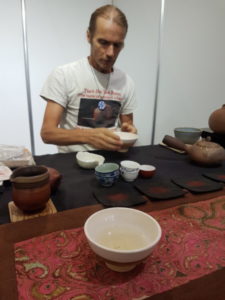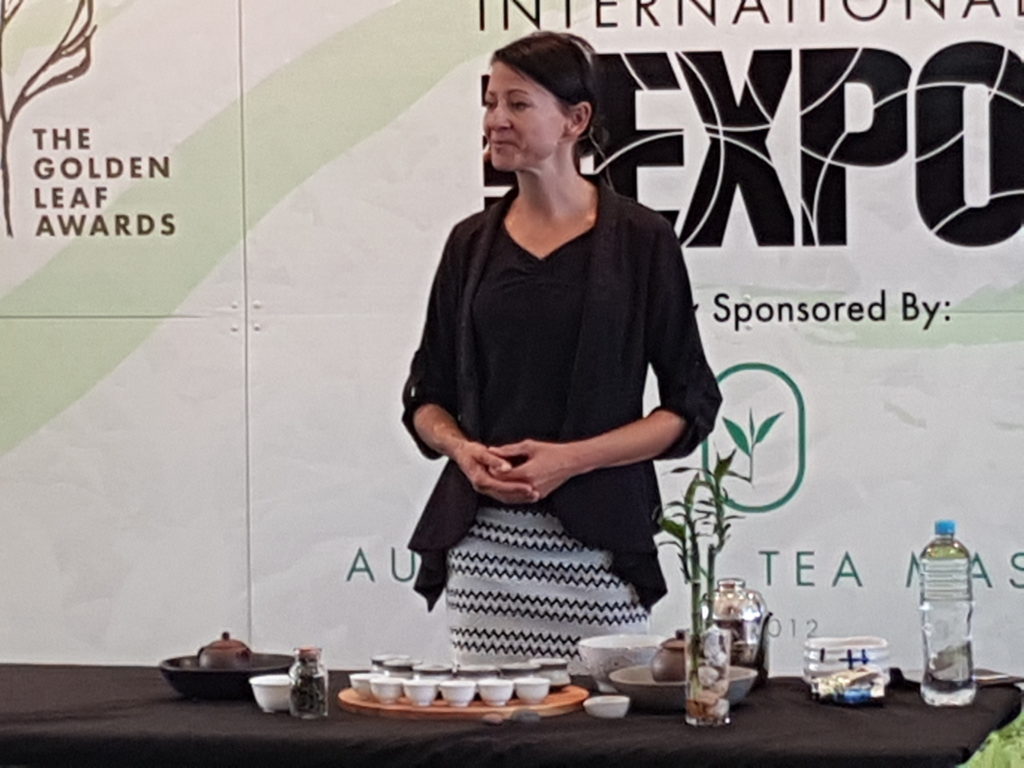Many tea drinkers I meet don’t drink coffee and, sadly, are also anti-coffee. I understand there are drinks out there that you never want to taste again (hello bourbon, goodbye bourbon) but the ferocity with which people barrack for Team Tea or Team Coffee is a damn shame. Not only does it close their minds to the rich and complex flavours of the two beverages, it puts up a false divide between them as if you can’t love one and drink the other.
Readers, I drink coffee. I drink one coffee nearly every day. I am no connoisseur – my standard order is either a flat white or a mocha, which is pretty much a hot chocolate spiked with a double espresso – but I enjoy my coffee and then I have some water and then I drink tea.
I mention this because one of the publications I write for is BeanScene, whose readership is cafe owners and for whom I write a tea feature every issue. Every year Prime Creative, the company behind BeanScene and other coffee publications, hosts the Melbourne International Coffee Expo (MICE), which is primarily a trade show for coffee and equipment wholesalers but which opens to the coffee-loving public too.
Following this model, this year the Australian International Tea Expo, previously seen in Geelong in 2015, set up in a small pavilion next door to MICE over 30 March to 1 April, hoping to lure beverage aficionados to the light side, as it were.
Unfortunately, despite moving from Geelong to the more populous Melbourne, foot traffic remained very thin throughout the expo*. I’m not privy to how much trade occurred on the floor, but the few business visitors I met were start-ups and looking for small-scale supply. I’d wager most of the sales were retail.
However, it was nice to see some old friends—brands like Yunnan Village (soon to be rebranded Wild Yunnan), Impala & Peacock and The Tea Project—and new faces such as Arakai Estate, Endeavour Tea and Sensado on the floor. Kent, from Tian He in Sydney, came down to play some music and set up a brewing bar in one of the stalls and I must confess I spent most of my spare time there sipping brews and chatting to passers-by.
*If you hear reports of 12,000 people there, keep in mind that the official figure for attendance at MICE was 9,646 over the three days and only a fraction of those people made it across to the tea expo.
Three tea Cups
The most interesting event at the expo was the Tea Masters Cup, held on Friday 31 March. The Cup actually comprises three categories with three winners that go through to the world finals. Contestants can choose to enter one, two or all three segments, which are Tea Preparation (the contestant brews and serves one tea of their choosing and one tea supplied by the organisers), Tea Pairing (the contestant serves tea paired with a morsel of food) and Tea Tasting (the contestant samples 10 types of tea and identifies them).
Being the first time I’ve attended a tea competition (I know!), I was surprised to learn how detailed and lengthy the presentations are. Tea Preparation, for example, involved a 15-minute presentation, with marks for information, presentation and charisma, as well as what ends up in the judges’ cup.
Obviously that last part can’t be judged by the viewing public but my personal favourite was Mandy Suess from Sensado. The eventual winner was my acquaintance, Cheryl Teo of Flag & Spear Tea Hunters.
The second round was similarly impressive, with a degustation style feast for the judges as five contestants presented their pairings. I can’t help feeling because food is such an important part of this segment that contestants who have a food prep/cooking skills (or access to them) are at a slight advantage. Nevertheless it was very interesting to hear about why each morsel had been paired with its tea and a good start for further experimentation for those playing along at home.
I had to go in the mid-afternoon so missed witnessing the third round, though from what I saw in photos it was the contestants with spoons tasting prepared tea, so not as informative as the previous segments.
Stalled education
One thing I found particularly disappointing about the expo was the handling of the workshops. I’d booked into two: Tea Mastery with Tatiana (a ‘tea master champion’) and Tea in the Media with Dan Bolton, editor of Tea Journey.
When I rocked up for the first on Saturday morning I went to the front desk to ask where the workshops were held and the girl there told me it’d been cancelled because Tatiana was stuck in China. Seeing as Tatiana was supposed to have done an earlier workshop on Thursday, it meant that the expo organisers knew she wasn’t coming two days prior. The most basic courtesy would’ve been to email or text the ticketholders to say so—after all, isn’t this why we fill in our contact details when we book in?!
Then I noticed a run sheet for the other workshops and Dan Bolton’s session had been moved from a workshop to the main stage. If anyone could see him, what had I paid for? I queried. Apparently ticketholders would get a free subscription to the magazine. “I’m already a subscriber.” “Oh. Just write your name here and I’ll process a refund.” (As it turned out, Dan was happy to give one to anyone who wanted a trial subscription—so much for that).
Two weeks later I have seen no refunds to my Paypal account. I’m not happy that I have to go through the tedium of chasing them.
(UPDATE 19/04/17: I have since applied for and received a refund through Paypal.)
As for the session: Dan has a lot of experience not just working in the media but working specifically in the tea and coffee industry and this came through strongly in his introduction. He gave an excellent contextual overview of tea in the media—which in many ways reflected the state of the media at large as dominated by newsy clickbait—assuring us that niche topics like tea actually generate the most genuine engagement from readers.
This seguéd into why he started Tea Journey and how the magazine gets put together: a combination of people pitching to him, commissioning writers, and translating articles including from Chinese publications Cha Dao Life and Pu’erh Magazine. At this point the presentation became more focused on the kinds of stories that appear in the magazine, which I thought was a little redundant seeing as that’s self-evident when you read it.
The most interesting takeaway was his note on how to approach readers: “Treat the public like pro-sumers. Show them how to get value from their tea.” It’s definitely something I’ll be infusing in my own writing.
Best stalls
Completely subjective titles awarded by moi.
- Best newcomer: Endeavour Tea
- Best dressed stall: Original Chai Co
- Most unusual tea: soluble Da Hong Pao (look out for my review shortly!)
- Best unblended tea: Feng Qing Yin Zhen from Sensory Lab (in MICE)
- Best blended tea: Monk’s Garden from Impala & Peacock

